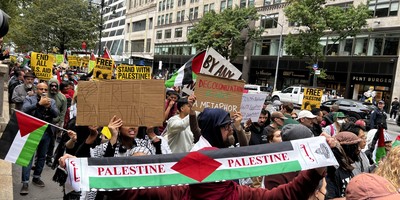According to the Bureau of Labor Statistics, approximately 118,423,000 Americans worked full-time in November 2008. According to the University of California at Santa Barbara's American Presidency Project, 132,645,504 people turned out to vote in that month's presidential election.
The presidential election voters outnumbered the full-time workers by 14,222,504.
In that election, then-Sen. Barack Obama won 69,297,997 popular votes and Sen. John McCain won 59,597,530. The 14,222,504 margin between presidential voters and full-time workers exceeded Obama's popular-vote margin of 9,700,467.
The ratio grows when you focus solely on full-time private sector workers.
On average over the course of 2008, according to the Bureau of Labor Statistic's Current Population Survey, there were approximately 120,030,000 full-time workers in the United States, and 18,528,000 of them worked for federal, state or local government. If you subtract these 18,528,000 full-time government workers from the 120,030,000 in total full-time workers, it leaves approximately 101,502,000 full-time private sector workers.
The 132,645,504 people who turned out to vote in the 2008 presidential election outnumbered the nation's 101,502,000 full-time private sector workers by 31,143,504.
It was not always this way.
In 1988, 1996 and 2000, full-time workers outnumbered voters. In 1988, there were 95,899,000 full-time workers and 91,594,693 voters. In 1992, the balance tipped the other way, with 104,405,155 voters and 97,847,000 full-time workers. In 1996, full-time workers again outnumbered full-time voters, 104,691,000 to 96,456,345. And in 2000, full-time workers outnumbered voters 114,076,000 to 105,586,274.
Recommended
The Bureau of Labor Statistics has published the month-by-month number of full-time workers going back to 1968. In the five presidential elections from that year through 1984, voters did outnumber full-time workers. But the American labor force had a different composition in 1968 than it did in 2008. In November 1968, 57.6 percent of the American population 16 or older worked. That was not tremendously different from the 61.4 percent who worked in November 2008.
In November 1968, however, only 41.8 percent of American women 16 or older worked. By November 2008, that had grown to 59.4 percent.
By contrast, in November 1968, 77.6 percent of American men 16 or older worked. By November 2008, that had dropped to 67.3 percent.
As of August, only 64 percent of American men were working.
What happened? Why did the percentage of American women working climb while percentage of men declined?
Liberals might point to this as a sign of societal progress, the success of women's liberation.
A better explanation may be this: Women are being driven into the American workforce -- and men are being offered a way out -- by the demise of the traditional family and the rise of paternalistic government.
In 1965, the federal government spent 17.2 percent of gross domestic product. In 2012, it will spend 24.3 percent.
In 1969, 2,878,000 Americans collected food stamps. That was about one for every 23 Americans who worked full-time. In 2011, 44,709,000 Americans collected food stamps. That was about one for every 2.5 Americans who worked full-time.
In January 1969, 1,302,608 Americans collected federal disability insurance. That was about one for every 50.5 Americans who worked full-time. In January 2012, 8,595,967 Americans collected disability. That was about one for every 13 Americans who worked full-time.
For tax year 2009, according to the IRS, 140,494,127 Americans filed tax returns but only 81,890,189 owed any income tax.
At the height of the Reagan era, a higher percentage of people who filed tax returns paid taxes and a larger actual number of Americans paid income taxes. In 1986, 103,045,170 Americans filed tax returns, and 83,967,413 of them -- or 81.5 percent of them -- paid income taxes.
The problem in America today is not that the rich don't pay their fair share in taxes. Nor is it solely that some pay no taxes at all.
The problem is that government has divided America into two camps: those who work and pay, and those who take and take.
























Join the conversation as a VIP Member